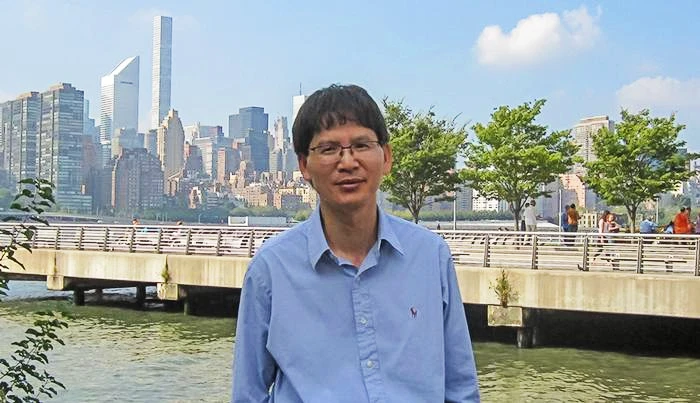In a significant advancement for the field of mathematics, Professor Pham Tiep of Rutgers University has solved two fundamental problems that have puzzled mathematicians for decades. Tiep’s breakthroughs in representation theory of finite groups could have far-reaching implications across various scientific disciplines.
Summary: A Rutgers professor has resolved two long-standing mathematical challenges, potentially advancing our understanding of symmetries in nature and science, as well as random processes in multiple fields.
Estimated reading time: 5 minutes
Professor Pham Tiep, the Joshua Barlaz Distinguished Professor of Mathematics at Rutgers University-New Brunswick, has made a double breakthrough in the realm of higher mathematics. His work has resulted in the resolution of two separate problems that have long eluded mathematicians, potentially paving the way for advancements in fields ranging from chemistry and physics to computer science and economics.
The first of Tiep’s achievements is the proof of the 1955 Height Zero Conjecture, proposed by renowned German-American mathematician Richard Brauer. This conjecture, which has stood as one of the most significant challenges in the representation theory of finite groups, was finally resolved and published in the September issue of the Annals of Mathematics.
Reflecting on the magnitude of this accomplishment, Tiep stated, “I was hoping to advance the field. I never expected to be able to solve this one.”
The Power of Conjectures
Conjectures play a crucial role in mathematics, serving as guideposts for future research. As Tiep explains, “A conjecture is an idea that you believe has some validity. But conjectures have to be proven.”
The Height Zero Conjecture is part of a series of mathematical challenges posed by Brauer in the 1950s and 1960s. Tiep’s work, along with that of his colleagues, follows what could be described as a blueprint laid out by Brauer decades ago.
Tiep’s admiration for Brauer’s intellect is evident: “Some mathematicians have this rare intellect. It’s as though they came from another planet or from another world. They are capable of seeing hidden phenomena that others can’t.”
A Second Breakthrough
In addition to solving the Height Zero Conjecture, Tiep has made significant progress in another area of representation theory known as the Deligne-Lusztig theory. This work, detailed in two papers published in Inventiones mathematicae and Annals, focuses on the concept of traces in matrices.
The implications of this second breakthrough are substantial. Tiep believes that insights from this solution will greatly enhance mathematicians’ understanding of traces and could potentially lead to breakthroughs in other important mathematical problems.
The Impact on Mathematics and Beyond
Stephen Miller, Distinguished Professor and Chair of the Department of Mathematics at Rutgers, emphasizes the significance of Tiep’s work: “Tiep’s high-quality work and expertise on finite groups has allowed Rutgers to maintain its status as a top world-wide center in the subject.”
Miller adds, “Through his amazing stretch of strong work, Tiep brings international visibility to our department.”
The breakthroughs in representation theory of finite groups have potential applications far beyond pure mathematics. This field is an important tool in various areas of mathematics and physical sciences, including:
- Number theory
- Algebraic geometry
- Particle physics
- Molecular symmetry studies
- Message encryption
- Error-correcting codes
The Process of Mathematical Discovery
Unlike many researchers in the physical sciences who rely on complex equipment, Tiep’s work is done with just a pen and paper. His research process involves jotting down mathematical formulas, engaging in conversations with colleagues, and often finding inspiration in unexpected moments.
“Maybe I’m walking with our children or doing some gardening with my wife or just doing something in the kitchen,” Tiep said. “My wife says she always knows when I’m thinking about math.”
These breakthroughs are the result of years of dedicated work. Tiep has been thinking about the Brauer problem for most of his career and has worked on it intensively for the past decade.
As the mathematical community celebrates these significant advancements, the potential applications and implications of Tiep’s work continue to unfold. His solutions not only resolve long-standing mysteries in mathematics but also open new avenues for exploration and discovery across multiple scientific disciplines.
Quiz
- What is the name of the conjecture that Professor Tiep proved?
- In which journal was the proof of the Height Zero Conjecture published?
- What is the second area of representation theory where Tiep made a breakthrough?
Answers:
- The 1955 Height Zero Conjecture
- Annals of Mathematics
- Deligne-Lusztig theory
Further Reading
Glossary of Terms
- Representation Theory: A branch of mathematics that studies abstract algebraic structures by representing their elements as linear transformations of vector spaces.
- Finite Groups: Mathematical structures consisting of a finite set of elements and an operation that combines any two elements to form a third element.
- Height Zero Conjecture: A mathematical conjecture proposed by Richard Brauer in 1955 relating to the representation theory of finite groups.
- Deligne-Lusztig Theory: A theory in representation theory that provides a way to construct representations of finite groups of Lie type.
- Traces: In linear algebra, the trace of a square matrix is defined as the sum of the elements on the main diagonal of the matrix.
- Matrix: A rectangular array of numbers, symbols, or expressions, arranged in rows and columns.
Enjoy this story? Get our newsletter! https://scienceblog.substack.com/
If our reporting has informed or inspired you, please consider making a donation. Every contribution, no matter the size, empowers us to continue delivering accurate, engaging, and trustworthy science and medical news. Independent journalism requires time, effort, and resources—your support ensures we can keep uncovering the stories that matter most to you.
Join us in making knowledge accessible and impactful. Thank you for standing with us!

